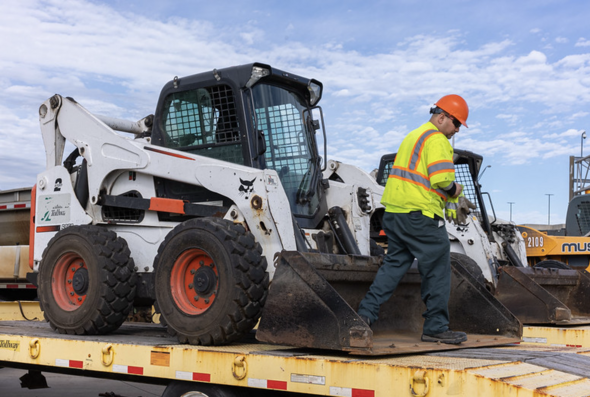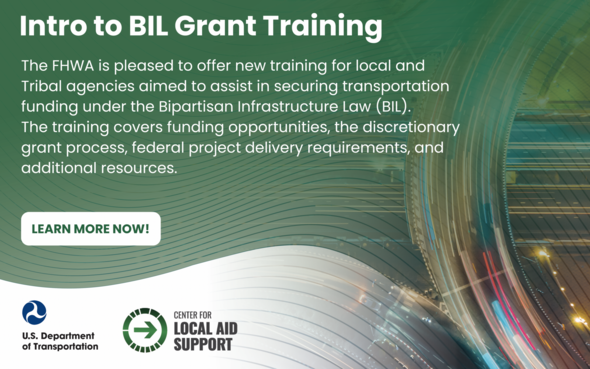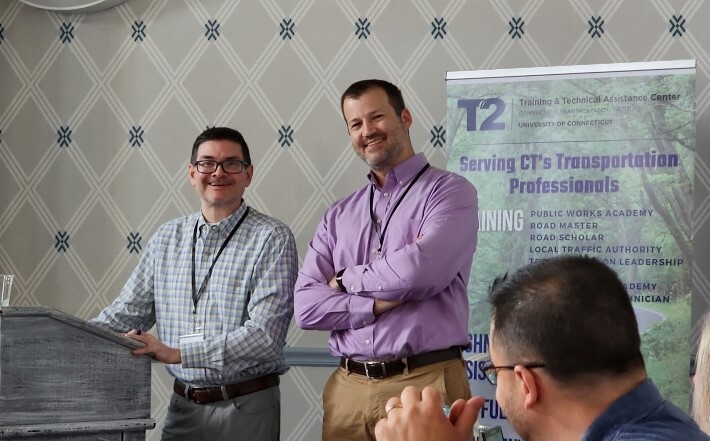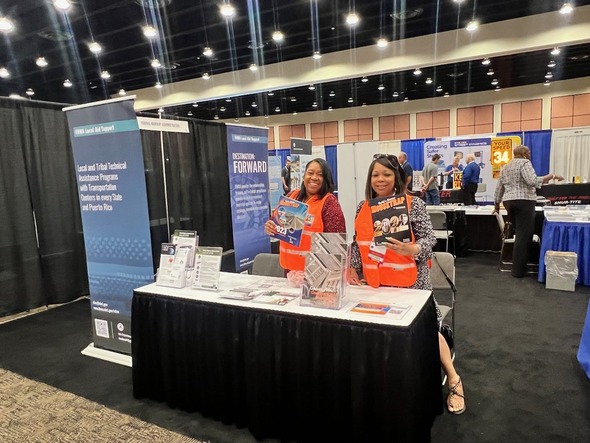Local Aid Support Newsletter Spring 2024U.S. DOT Federal Highway Administration sent this bulletin at 06/05/2024 08:21 AM EDT  14th Edition
Spring 2024
14th Edition
Spring 2024
Welcome!
Trainfo© Project, City of New Haven, IN
Courtesy of the City of New Haven for Build a Better Mousetrap. The City of New Haven, Indiana contends with at-grade railroad crossings, lacking tunnels or overpasses to reroute traffic in the event of blockages. This circumstance leads to pronounced delays, traffic congestion, and prolonged emergency response times. In addressing this challenge, New Haven partnered with Trainfo©, a transportation system company, to implement a sensor and communication system that collects and shares information regarding the movement of trains. They installed sensors and a message board near the train tracks, allowing remote access to the tracking portal, which can be integrated with their dispatch system. This new system will support public safety among train and vehicle users. By furnishing the city's 911 dispatch center with their expert knowledge and real-time mapping data, Trainfo effectuated a 21% reduction in vehicular interactions at active crossings and a 30% alleviation of congestion.
Through strong collaboration with technology companies and transportation experts, LPAs are at the forefront of developing innovative solutions to enhance transportation infrastructure. For more information on this innovative solution, please contact Pone Vongphachanh at 260-748-7041 or pone@newhaven.in.gov. "Safe Sighting of Signs and Signals" Program, City of Moreno Valley, CA
Courtesy of City of Moreno Valley, CA for Build a Better Mousetrap. The City of Moreno Valley, California with a population of 210,000, has seen rapid population growth within the last ten years, and has struggled to upgrade its infrastructure. One of its important transportation improvement projects is the reconstruction of the State Route 60 (SR-60)/Moreno Beach Drive Interchange to enhance safety, reduce traffic congestion, and provide multimodal transportation mobility for the future build-out of the city.
The program presents an exceptional opportunity for community members to gain insight into the latest construction technology, equipment, material usage, traffic control, layouts, and the various stages of construction. Not only has this program heightened public awareness of improvements and promoted transparency, but it has also effectively managed traffic and trips, while significantly contributing to enhanced safety in and around construction sites. Road Widener Improvements, Redwood County Highway, MN
Courtesy of California Dept. of Transportation for Build a Better Mousetrap. The Redwood County Highway Department encountered a county-wide safety problem due to unsupported pavement edges and shoulder drop-offs, causing vehicles to swerve and create a hazardous situation. The maintenance team traditionally relied on a crew-made, belt-fed, gas-powered shouldering machine attached to a road grader, which proved to be inefficient and frequently broke down. The County solved the issue by modifying the road widening machine by attaching a motor grader or skid loader to it. The modifications were created in the County's welding shop and as a result, improved road shoulder maintenance operations.This innovation saved time when conducting shoulder maintenance for drivers' safety when they have to pull off of the road.
In conclusion, the innovative modifications made have not only addressed a critical safety concern but have also showcased the power of ingenuity and adaptability in infrastructure management. By transforming existing machinery to meet specific needs, the County has not only improved efficiency but has also prioritized the safety of road users. This proactive approach serves as a testament to the department's commitment to enhancing the overall quality and safety of the county's roadways, ultimately contributing to a smoother and safer driving experience for all. Go The Extra Mile for Safety Award, Illinois Tollway, IL Courtesy of Illinois Tollway for Build a Better Mousetrap. The Illinois Tollway wanted to ensure that safety is a top priority not just for their customers but also their workers in the Road Maintenance Department. Their challenge/goal was to strengthen their internal culture of safety among the staff. The Illinois Tollway created the "Go the Extra Mile Safety Award" to positively reward safe behavior and strengthen the culture of safety at its maintenance facilities among staff members. The name of the award was selected based on ideas submitted by Illinois Tollway employees to give them ownership over the project. To support this effort, the Illinois Tollway also created a series of videos, called "Protect your Assets," which featured the employees who demonstrated the safest ways to avoid injuries on the job. As a result of the program, the Illinois Tollway saw a reduction in the number of workers compensation claims. The workers conducted more than 100 'Toolbox Safety Talks' activities and for the first time ever, the Tollway saw at least three facilities go without a single injury in one year.
The Illinois Tollway's culture of innovation is reinforced by fostering collaboration between different departments, tapping into different ideas and perspectives. The Tollway further encourages innovation by recognizing and rewarding successes throughout the agency. For more information on this innovative solution, contact Paula Blonski at 630-432-1037 or pblonski@getpass.com.
Connecticut Municipal Local Traffic Authority Education Program
CT Training and Technical Assistance Center. Every Town or City in Connecticut (CT) has a designated Local Traffic Authority (LTA). LTAs are responsible for many regulatory items on local roads. The first point of contact for any traffic related concern on any public road is the LTA. The LTA also works with the CT Department of Transportation (CTDOT) and the Office of the State Traffic Administration (OSTA) on traffic-related matters on State roads. In 2023, the Connecticut State Legislature passed a law that all LTA's must attend an annual training program hosted through the Connecticut LTAP also called the Training and Technical Assistance Center or T2 Center. To assist the LTAs in meeting this legislative requirement, the T2 Center was able to quickly build an LTA 101 course with in-person and virtual options. Donna Shea, the T2 Center's Executive Director says, "...the whole team is SUPER proud of this program, and it is helping these LTA's make better decisions to ensure safer communities!" She also says the T2 Center was able to offer the initial 101 training at no cost to the LTA's, removing any fiscal barriers to their participation. "...this has grown into such a great partnership between the T2 Center, our Safety Circuit Rider Program, CT DOT Traffic Engineering, and the Connecticut Office of the State Traffic Administration," according to Donna. After completing this course, to satisfy future annual training requirements, LTAs can participate in the T2 Center's LTA certificate program. The T2 Center will continue to offer a variety of LTA required and elective classes each year. APWA Veterans in Public Works
[Garnar] stock.adobe.com The CT LTAP Center recently held a webinar on a partnership between the American Public Works Association (APWA) and the U.S. Department of Labor (DOL) called the Veterans' Employment and Training Service or VETS. The purpose of the program is to provide resources and information on job opportunities for veterans in Public Works Departments and local governments across the country. The opportunities offered by VETS include on-the-job training, apprenticeship programs, internships, and sponsored work placement options. Research shows that veterans, service members, and military spouses are among the most productive and committed employees in the workforce. They tend to have higher retention rates, larger labor participation rates, and lower unemployment rates than other groups. This makes them ideal candidates for critical and key roles in public works departments and local governments.
Next Generation of TTAPEach TTAP Center fosters new relationships with Tribal nations in their respective regions through outreach and inclusion in this Next Generation of TTAP. Per the FHWA TTAP Center cooperative agreements, each TTAP Center Steering Committee must have a minimum of 50% Tribal representation. This ensures that the local, Tribal context and perspective are provided for TTAP Center services and deliverables, including the Center Needs Assessment and Annual Workplan. By building these crucial relationships with Tribal transportation leaders, the TTAP Centers are better equipped to provide high-quality training and technical assistance, promoting greater success in delivering these crucial services to Tribal nations. Northern TTAP Center UpdateIn May, the National Tribal Road Maintenance Symposium visited Rapid City, South Dakota, hosted by the Northern TTAP Center. This event attracted Tribal Road maintenance practitioners and staff from the Bureau of Indian Affairs (BIA) Divisions of Transportation and BIA Regional Tribal Transportation Program. The primary objective of the symposium is to provide essential support for Tribal transportation directors, supervisors, planners, office staff, equipment operators, project managers, and other stakeholders.
Implementing the Safe System Approach on Roadways
Drones Are Replaceable, You Are Not!
Four pictures showing a bridge inspection, high mast inspection, a natural disaster with survey. Source is from the Texas Department of Transportation. In 2022, there were 1,069 fatal work injuries in construction and 1,053 in transportation and warehousing. To prioritize safety, the Texas Department of Transportation (TxDOT) employs unmanned aerial systems (UAS) to enhance highway worker safety. These UAS operate autonomously and can perform various tasks such as data collection and infrastructure inspection. TxDOT uses UAS for bridge inspections, surveying, responding to natural disasters, and high mast inspections. This outlines the SMS that promotes safe and efficient UAS. To learn more about TxDOT advancement in UAS for safety and how it works please contact Mr. Sergio Roman, UAS Coordinator/UAS Pilot, or Mr. Travis Scruggs, Geographic Information System Analyst/UAS Pilot, TxDOT. To learn more about FHWA support in the advancement of UAS or digital twin, please contact Mr. Bryan Cawley, Highway Engineer, FHWA, Resource Center. Navigating the Future of Transportation: Digital Delivery Transformation in OklahomaThe Oklahoma Department of Transportation (ODOT) is adopting a digital approach to streamline the project lifecycle. The ODOT Digital Delivery program began as a pilot cross-functional design team in January 2022 and has become a permanent, dedicated digital delivery team. The program enhances collaboration and communication among project stakeholders, optimizes resource allocation, and reduces costly rework and delays. The Digital Delivery program is paving the way for a smarter and more interconnected DOT.
Looking ahead, ODOT remains fully committed to exploring new opportunities to enhance its Digital Delivery capabilities. The agency is continuously seeking ways to engage with the larger engineering community on digital delivery topics and actively participates in the Building Information Modeling (BIM) for Bridges and the BIM for Infrastructure Transportation Pooled Funds. If you would like to learn more about ODOT's Digital Project Delivery you may contact Katie Brown, P.E., S.E., ODOT Transportation Quality Digital Delivery Engineer and PW Administration or Michael Pearson, ODOT Digital Delivery Manager. If you would like to learn more about FHWA efforts regarding Digital Project Delivery you may contact Bryan Cawley, P.E., Highway Engineer, FHWA Resource Center. 
BIL Competitive Grant ProgramsPlease visit https://www.fhwa.dot.gov/bipartisan-infrastructure-law/grant_programs.cfm to learn more. FHWA Announces Details of Low-Carbon Transportation Materials ProgramFHWA released the details of the Low-Carbon Transportation Materials (LCTM) Request for Applications (RFA). This RFA is open to DOTs, the District of Columbia, and the Territory of Puerto Rico. Additionally, FHWA plans to release a separate Notice of Funding Opportunity (NOFO) for eligible non-State DOTs in the near future. The LCTM Program, established under Section 60506 of the Inflation Reduction Act, aims to increase the use of materials that have "substantially lower levels of embodied greenhouse gas emissions" as defined by the Environmental Protection Agency. FHWA will award up to $2 billion in LCTM Program funding. $1.2 billion is available to States through the RFA process. The remaining $800 million will be made available to eligible non-State DOTs in the upcoming NOFO. State RFA applications must be submitted by June 10, 2024, at 11:59 p.m., EDT. Visit the LCTM page of the website for more information on the LCTM Program and the RFA. In coming weeks, FHWA intends to host informational webinars and release additional documents to support the program. Stakeholders are encouraged to sign-up for LCTM Program updates or email questions to the LCTM Program. Read more about the Low-Carbon Transportation Materials Grants Program. TETDDP Grants for Highway Construction Workforce DevelopmentFHWA recently released a NOFO to support State and Local Highway Construction Workforce Partnership (HCWP)/SWD Programs. The HCWP and SWD are the same programs. The SWD designation was made when the HCWP was included in the Every Day Counts-6 (EDC-6) and now EDC-7 programs. FHWA is making $4.2 million available for the grants with a limit of $300,000 per grant. State DOTs and Educational Institutions are also eligible grant recipients. The construction workforce development grants are intended to support a Working Group model already well-established in the existing HCWP/SWD programs. The grant program is funded through the Transportation Education and Training Development and Deployment Program (TETDDP). FHWA Announces New Highway Workforce Grant ProgramThe FHWA launched a grant program, called the Highway Construction Training Program (HCTP), with a total of $4.2 million to fund Strategic Workforce Development (SWD) programs, both new and existing ones. This program aims to train and place individuals in highway construction jobs. Eligible recipients for the grant are State Departments of Transportation (DOT) and educational institutions.
LAS is on the Move!
Trinette Ballard, LAS Program Manager joined the Florida and Tennessee LTAP teams for a photo during the LTAP Southeast region meeting in Chattanooga, TN.
Danielle Mathis-Lee and Trinette Ballard presented during the 2024 National Association of County Engineers in Palm Springs, CA.  Check out those smiles! LAS Acting Director Jeff Zaharewicz and LAS Program Manager Hans Anker were featured speakers during the NLTAPA Northeast Region meeting in Storrs, CT.  Trinette Ballard and Danielle Mathis-Lee wear orange for National Work Zone Awareness Week during the 2024 National Association of County Engineers Annual Meeting in Palm Springs, CA. The Road to Success - Available Online Training
Upcoming ConferencesJuly 16-18, 2024 Stay connected with FHWA on YouTube
Notice The U.S. Government does not endorse products or manufacturers. Trademarks or manufacturers' names appear in this presentation only because they are considered essential to the objective of the presentation. They are included for informational purposes only and are not intended to reflect a preference, approval, or endorsement of any one product or entity. |